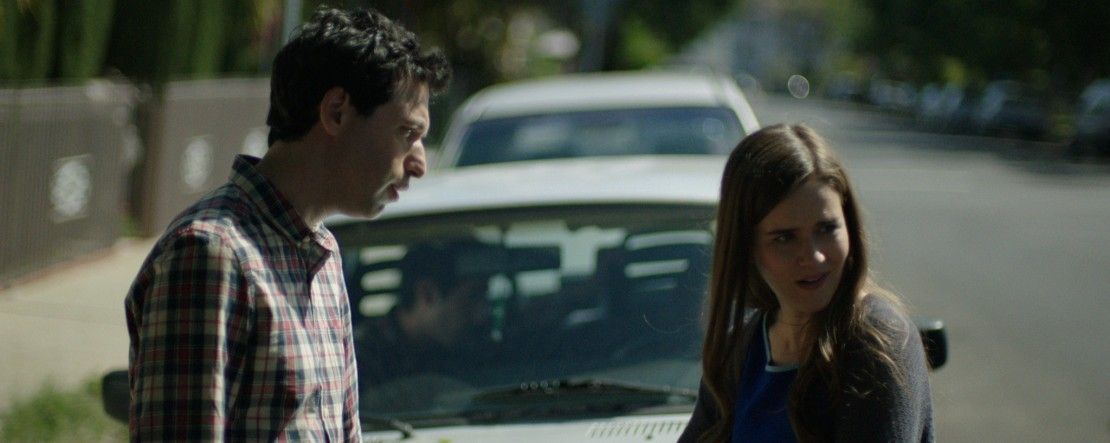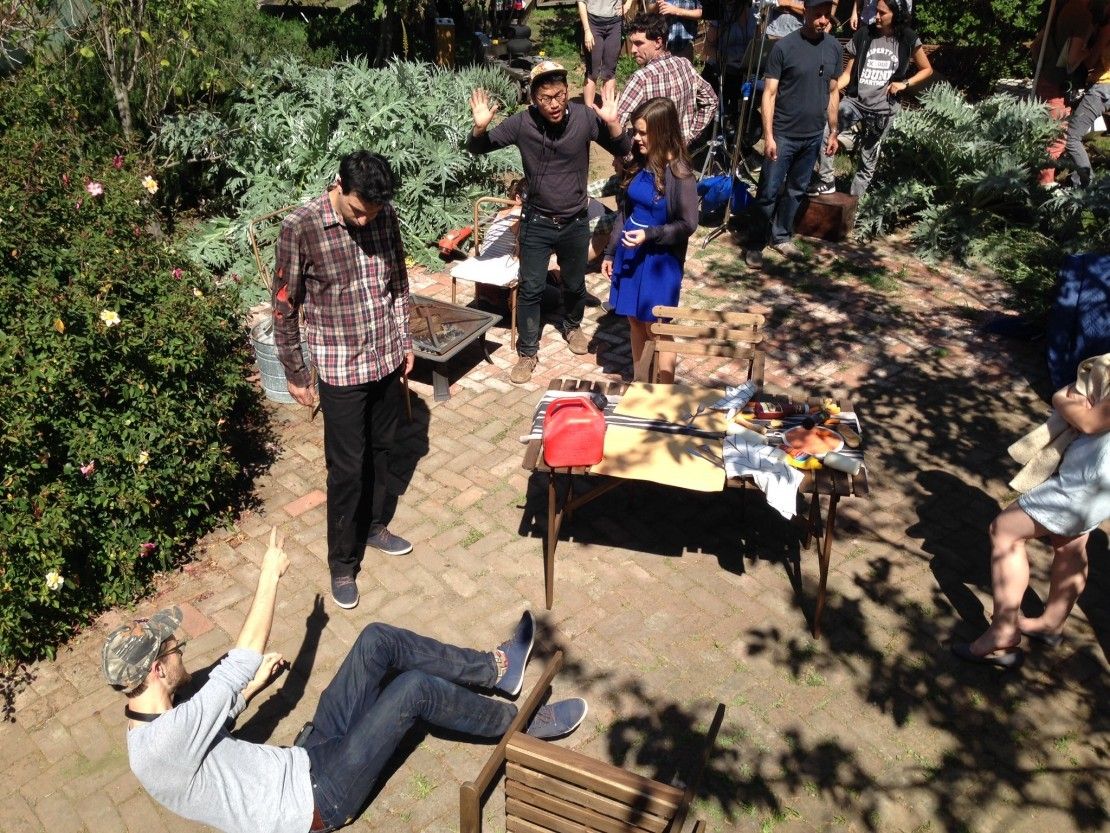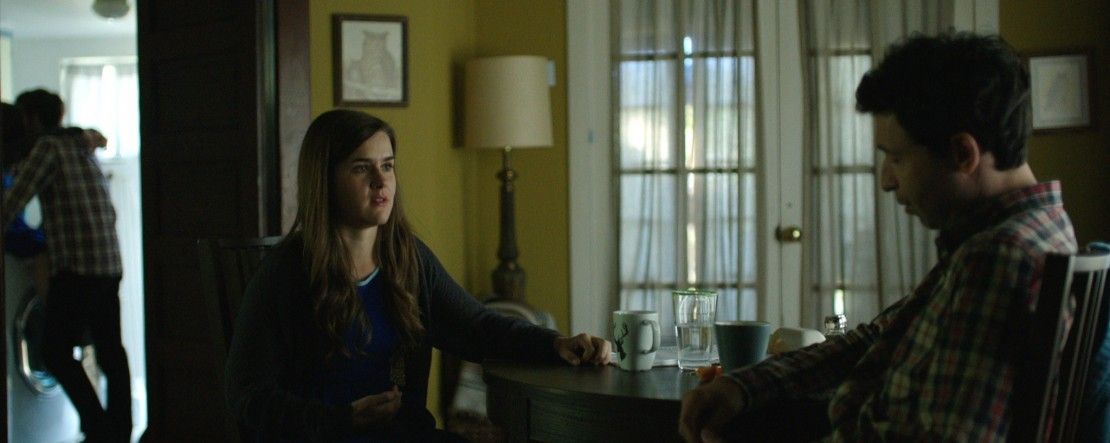
The directing duo DANIELS gives us the goods behind their new interactive short.
The two young men that are DANIELS have done it all, and often in the most outrageous of ways: from participation in the 2014 Sundance Screenwriters’ Lab (with a script about a farting corpse) to the production of that feature film (with another Daniel: Radcliffe, as said corpse) to directing a Nike commercial for the opening of this summer's Rio Olympics to high-profile music videos for the likes of DJ Snake & Lil Jon.
It is therefore no surprise that Daniel Kwan and Daniel Scheinert were ready to experiment with an evolving medium: interactive film. There have been several swings and misses in this ball field already, but the DANIELS short, Possibilia, is not a typical “choose-your-own-adventure.” Instead, it takes you inside one couple’s personal neuroses. The more you click, the more possibilities emerge, eventually elegantly converging into one conclusion before looping back to the beginning again.
"It's an overwhelming, terrifying, anxiety-inducing experience. I hope you enjoy."
You can experience the whole thing here (we encourage you to click a few times). Then, read our chat with DANIELS below to learn about the complex and intricate production behind the scenes.
No Film School: What do you mean when you say “interactive short”?
Daniel S.: The over-simplified version is like a “choose-your-own-adventure,” except you don't get stuck in one path. You have the opportunity to go to all the paths all at once. It's an overwhelming, terrifying, anxiety-inducing experience. I hope you enjoy.
It did start with reading those choose-your-own-adventure books when we were kids— this is deconstructing that and trying to apply that deconstruction to a real-life experience that everyone can relate to, which is breaking up. The breakup is us playing in our heads a choose-your-own-adventure , except we don't get the luxury of being stuck in one of the paths. In a breakup, we actually have to hold every single path in our arms all at once and then we end up saying terrible, stupid things to each other. Hopefully, the interactivity here helps the narrative rather than hurts it.
"We always try to pick a story that suits the interactivity."
NFS: I like the idea of the interactive short as a metaphor for a relationship itself.
Daniel S.: Yes, and for real life in general. It's one of the reasons we don't get as frustrated as we could when we make interactive [content], because we always try to pick a story that suits the interactivity. The idea of just sticking buttons on top of a good short film really stresses us out.
NFS: So that begs the question: why do it this way in the first place?
Daniel S.: The short answer is our friends at Interlude asked us to. But we were drawn to it because it's a fun challenge. I think a lot of times our music videos are really crazy because we get bored easily, so if we made a straightforward music video I don’t think we’d be invested the whole way through. We’d just kind of check out at a certain point. Interactivity has had a similar draw for us. It doesn't get boring. It's hard and challenging straight up through delivery. If anything, it actually gives us permission to make stories that are a little more straightforward, because we're working in a medium that's not as over-saturated with content.
"We like video games, and we were jealous. We wanted to make an interactive short because that's the closest we could get."
Daniel K.: Yes. There's a higher likelihood of failure. I think we chase projects that we might fail at because it forces us to stay on top of the project and it kind of terrifies us. We rarely ever see interactive films that work, outside of video games. Video games are amazing. The narrative films rarely have good interactivity, and that was terrifying to us. I think that's one of the reasons why we thought it would be an interesting challenge.
Daniel S.: Kwan also gave my other answer, which is: we like video games, and we were jealous. We wanted to make an interactive short because that's the closest we could get.

NFS: I was surprised, at first, that you chose the relatively banal topic of a breakup. Everybody has done that. But actually, you tackled it in a whole different way.
Daniel S.: Yes. I think in some ways, that was a weird thing that attracted us to it. As we worked on it, we realized that it was exciting to us to make the meat of the film actually banal. All of your attention is then focused on this crazy experience and how it's making you feel as opposed to what sort of quirky career our characters should have.
Daniel K.: It's more of a post-modern deconstruction of what a breakup is or what a breakup can be.
Daniel S.: I've been describing it, actually, as not a breakup film. It's a film about those fights you have when you're in a relationship. The movie is about those repetitive fights and that feeling you get when you're in there. That's actually something I didn't think I'd seen much in films. You know? Movies usually pick that super dramatic turning point. This is actually about that very existential no man's land feeling.
"We wrote a script then and kept it really general so that it lent itself to being reinterpreted sixteen different ways."
NFS: What was scripting for interactive like? How did you approach it differently from a straightforward narrative feature?
Daniel S.: The whole thing is this weird process that we invented as we went. We very roughly outlined it first then came up with how many shifts there were going to be in the story. At which point would more choices appear?
Daniel K.: Right. When would the characters branch off?
Daniel S.: We broke it down: you go from one to two to four to eight to 16 possible directions, and this is generally what’s gonna happen. Then, we found a location and worked up an Excel doc that broke down which rooms they would travel into and which different activities and different ways the story could go. Only then did we actually write a script out. I think we had bits of dialogue, but we wrote a script then and kept it really general so that it lent itself to being reinterpreted 16 different ways.
Daniel K.: Whenever we made it too specific, it wouldn't work for seven other different versions of the same dialogue. Kind of like we were saying before, it doesn't have a specific narrative to it, so that it lends itself to having multiple interpretations and multiple contexts and multiple emotions from the same exact line. That was a really fun experience.

Daniel S.: We described it once as almost like acting classes where you can say the same lines in ten different ways and see how just the simple performance changes everything.
Daniel K.: Once we wrote that script, the actors very loosely followed it, and we recorded improvised scenes with them. Following the structure, we chopped that up and created an audio-only track that the actors had to memorize. They would have a little earphone hidden in their ear during the shoot and have to lip sync to themselves. Which was funny. Lip syncing, you're usually singing. In this case, they hear themselves in their ears while trying to act well.
"We were constantly looking for fun little visual treats to give the audience."
NFS: What about blocking? How did you direct the scenes so they would flow into one another?
Daniel S.: We mapped out the story from the front yard to the backyard with a little detour that takes you upstairs. As it spreads out, everything geographically is in a line. We were constantly looking for fun little visual treats to give the audience. We just tried to choreograph things where you get little glimpses into the other stories. It all times out the same. Only if you watched it 100 times, you'd learn the choreography.
When the couple start having their little trip down memory lane, it's only about 30 seconds, but it's probably one of our favorite parts of the whole film. There's so many little gems because there are sixteen of those stories.
Daniel K.: The audience is no longer exploring different perspectives. They're basically exiting their own memory montage, because every time you switch storylines, you're cutting to another memory of the couple’s. They reminisce, but you decide how often you need to switch to different memories.

NFS: Was there a point during this process when you either thought, “We know it's going to work,” or, “This is definitely not going to work?”
Daniel K.: We never really know if anything we do is going to work until it's done, but even with this thing, we ended it and we didn't have the technology yet figured out. It would just be guesswork: "Yes. This makes sense to me, but how does someone who has no idea what they're going to do or what's going to happen interact with this thing?" Sometimes we don't know if it's going to work until we see a complete stranger watch it.
"This whole thing is a weird social experiment."
Daniel S.: We still don't know if it works. I think one of the things that was appealing about this project was, as opposed to making a viral video that you feel real confident is going to have the maximum appeal to some certain demographic, this whole thing is a weird social experiment. For the last two years, we've taken it to film festivals, and it plays in gallery settings. A lot of times, it falls on its face; people click twice and walk away. Every once in a while, it really hits someone hard, and they spend a half hour on it, and they won't stop talking to us about it.
NFS: Now that you've been through this process, how would you advise someone who wants to try making an interactive film?
Daniel S.: It's so much more rewarding to do an interactive piece when the story itself is interactive. [Think about] the fact that it would not be a good short film if you took interactivity away. It would be a weird thing. I've talked to people and seen other interactive things where people end up regretting making an interactive. It seems like two separate things, the short and the buttons.
NFS: In other words, interactivity should be integrated from the very beginning instead of tacked on?
Daniel S.: More or less, yes. I think the way to integrate it from the beginning is to use it as inspiration when you're writing. Try to make sure that you have the interactivity schematically somewhere in there.
I think one of the biggest learning experiences, as someone who's never done interface design...I totally under-appreciated how the smallest changes, like where you put buttons, could affect a viewer. How frustrated a viewer will get if it doesn't work the way they think it will? What's the sound effect? Is there enough feedback? You can't overestimate how important those little things are.
Daniel S.: And it takes a lot more time than you think. It's a six-page script, maybe, but then you multiply that by how many branches there are. For us, it was like 45.
NFS: Wow.

Daniel K.: It was crazy.
Daniel S.: One of the people who saved our butts on this was our Assistant Editor, Kyle Gilbertson. The quantity of files—even just exporting and coming up with a naming structure and trying to keep everything organized is way more important on this than it would be on a normal video.
"I enjoy filmmaking when I use it as therapy."
Daniel K.: Every time you cut out time for one branch, you have to change the cuts and the timing for every single other branch. Every little thing becomes another math problem.
Daniel S.: [Gilbertson] was even on set, and that was so great. While we were shooting, he would lay in takes on top of each other and be like, "Hey guys, it's working." Or, "Oh no. The dialogue is way off."
NFS: Now that you've moved through all these different formats— music video, feature, short, interactive short— what have you learned about your own approach?
Daniel S.: I think the big thing I've learned lately is that I enjoy filmmaking when I use it as therapy. There's no one medium that I want to do forever. My favorite experiences are when I do a certain project, and I really need that kind of project in my life right then. I wouldn't just jump into a feature if I wasn't emotionally ready.
Daniel K.: In every one of the mediums, when we came up with an idea and we felt like we could go for it, usually it was because I couldn't imagine someone else making that project in that medium. It felt really good to just look at something and be like, if it wasn't for us, this thing wouldn't exist. That's why we have to be the ones to make it. I don't think most of the projects that we've worked on that have been really successful could have been made by other people, but I don't think anyone would want to make them. We'll continue that trend, hopefully. Do a lot of things that scare us.
NFS: Anything else you'd like to add?
Daniel S.: You don't need film school.
Your Comment
5 Comments
Amazing concept. Bravo!
August 10, 2016 at 9:51PM
Folks, this is really really well done, and you had some critical insights that'll form the foundations of future work in this experiential genre! Nicely, nicely done!! Congrats!
August 11, 2016 at 8:31AM, Edited August 11, 8:31AM
I'm pretty sure I saw this a year ago as an installation at the Museum of the Moving Image in Astoria, New York, before I even knew of DANIELS.
August 11, 2016 at 8:21PM
good post
August 12, 2016 at 3:52AM, Edited August 12, 3:52AM
I love reading this. It makes me learn something new, every time i read any article on this site. Film making is my hobby, i might be movie director but its late now. I am already a Tech Guy. Cheers and appreciate your efforts to share your experience.
August 30, 2016 at 11:12AM